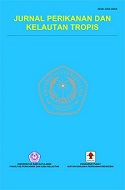The Analysis of Potential Resources of Small Pelagic Fish in Ambon City Waters
DOI:
https://doi.org/10.35800/jpkt.v12i3.47663Keywords:
Maximum Sustainable Yield, overfishing, Pelagis KecilAbstract
Moreover, the research may provide information to the business actors or investors as basic to make decisions about the development of fishing industries which are expected to optimize catches and ensure the sustainability of fish reserves in the waters of Ambon City. The potential of pelagic fishery resources was analyzed using the Surplus Production Model (MPS). The production surplus model can be applied if there is a reliable estimate of the total catch or Catch Per Unit Effort (CPUE) and associated fishing effort for the period 2006 – 2015. The regression calculation results in a coefficient value of α= 62.033 and β= -113.031 so that the CPUE regret equation for effort can be written as ht= 62.033 – 113.031, with R2= 0.61 stating that 61% CPUE can be explained by the effort (trip) of catching small pelagic fish. and the remaining 39% is explained by the other factors). Sustainable production at a maximum sustainable yield (MSY) of 9244 tons/year can be achieved if the fishing effort is around 41057 trips. The results of the analysis show that the MSY obtained is 9244 tons/year with an effort (fmsy) of 41057 trips/year the number of allowable catches (JTB) of 6808.92 tons/year and a potential of 61%
Keywords: Maximum Sustainable Yield, overfishing, Ikan Pelagis Kecil
Abstrak
Penelitian ini dapat memberikan informasi agar pelaku usaha atau investor dapat mengambil keputusan tentang pengembangan usaha penangkapan diharapkan akan mengoptimalkan hasil tangkap serta menjamin kelestarian sumberdaya ikan di perairan Kota Ambon. Potensi sumberdaya perikanan pelagis dianalisis dengan Model Produksi Surplus (MPS). Model surplus produksi dapat diterapkan jika tersedia estimasi yang meyakinkan atas hasil tangkapan total atau Catch Per Unit Effort (CPUE) serta upaya penangkapan yang terkait periode 2006 – 2015. Perhitungan regresi menghasilkan nilai koefisien α= 62.033 dan β= -113.031 sehingga persamaan regresi CPUE terhadap upaya dapat ditulis sebagai ht= 62.033 – 113.031, dengan R2 = 0,61 menyatakan bahwa 61% CPUE dapat diterangkan dengan upaya (trip) penangkapan ikan pelagis kecil dan 39% sisanya diterangkan oleh faktor lainnya). Produksi lestari pada maximum sustainable yield (MSY) sebesar 9244 ton/tahun dapat tercapai bila upaya penangkapan sebesar 41057 trip. Hasil analisis menunjukan bahwa MSY yang diperoleh sebesar 9244 ton/tahun dengan upaya (fmsy) sebesar 41057 trip/tahun serta jumlah tangkapan yang diperbolehkan (JTB) sebesar 6808.92 ton/tahun dan potensi sebesar 61%.
Keywords: Maximum Sustainable Yield, overfishing, Ikan Pelagis Kecil
References
Dinas Kelautan dan Perikanan. Laporan Tahunan 2011. Laporan Tahunan Provinsi Maluku. Ambon
Akpalu, W. (2009). Economics of biodiversity and sustainable fisheries management. Ecological Economics, 68 (10), 2729–2733. https://doi.org/10.1016/j.ecolecon.2009.05.01 4
Badruddin, 2005. Analisis Data Catch & Effort untuk Pendugaan MSY. Fisheries Specialist, Indonesian Marine And Climate Support (IMACS) Project. USAID Indonesia – KKP.
Laporan LPPD Kota Ambon, 2014. Pemerintah Kota Ambon, 2014. Bab I (Hal.14)
Myers, R.A.,Worm, B., 2003. Rapid worldwide depletion of predatory fish communities. Journal Nature 423, 280–283.
Downloads
Published
How to Cite
Issue
Section
License
Copyright (c) 2024 Aniesa Nabila

This work is licensed under a Creative Commons Attribution-NonCommercial 4.0 International License.











